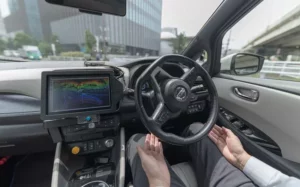A researcher at WMG, University of Warwick has set out a series of points that autonomous vehicle developers must consider when it comes to safety.
Dr Siddartha Khastgir has been advising the World Economic Forum on identifing the frameworks for Government to enrol Autonomous Vehicles.
In the report, “Safe Drive Initiative: SafeDI Scenario-Based AV Policy Framework – an overview for policymakers”, published by the World Economic Forum, Dr Khastgir contributed to the technological aspects of the policy framework building on his UKRI Future Leaders Fellowship research outcomes.
The Safe Drive Initiative seeks to establish a high-level framework to enable regulators and AV developers to work collaboratively to demonstrate an AV system’s capability to operate without intervention from a driver. The initiative proposes a data-driven, scenario based assessment using a graduated approach to safety assurance. The framework’s approach is vehicle and solution-agnostic and builds upon existing national and international standards, where possible. The approach focusses on assessing AV in the context of its deployment ODD by demonstrating behaviour competence in a range of scenarios and covers using simulation, driving in controlled environments and naturalistic on-road driving for evaluation. This can then be adopted by a regulator or government entities, which are responsible for managing AV development and deployment.
The report has highlighted numerous points of testing that all bodies should follow around preparation, definition, measurement and execution.
The graduated approach enables defining interim milestones as a function of deployment ODD. After completing all steps of the assessment regulators should have a clear idea of which AV developers are ready to operate commercially in the deployment operational design domain. Ideally, the AV developer should demonstrate the vehicle’s capability to operate without a safety driver, but this depends on back-up on mechanisms such as minimal risk manoeuvres and remote operators to take control should they meet a rare situation it is not designed to handle, for example if an emergency vehicle is approaching.
Dr Khastgir commented, “Although this framework is for all regulators who want to implement an operational safety assessment within their jurisdiction, not one-size will fit all, different towns and cities all over the world will have different concerns based on their respective Operational Design Domains, and therefore each step should be customised for each community. Defining the interim milestones and qualitative scenarios as a function of deployment ODD, enables this framework to be used by wide variety of stakeholders like manufacturers, governments, local-authorities etc.
“We do however hope that this framework will help us see the safe development and deployment of CAVs, so that in the future we can see the benefits of safe, clean and inclusive mobility. WMG are already researching this in many ways, as we are leading the Midlands Future Mobility testbed, which sees autonomous vehicles being tested on real worlds, and have the facilities, such as the 3xD simulator to test AVs before they go on real world tests.”





















